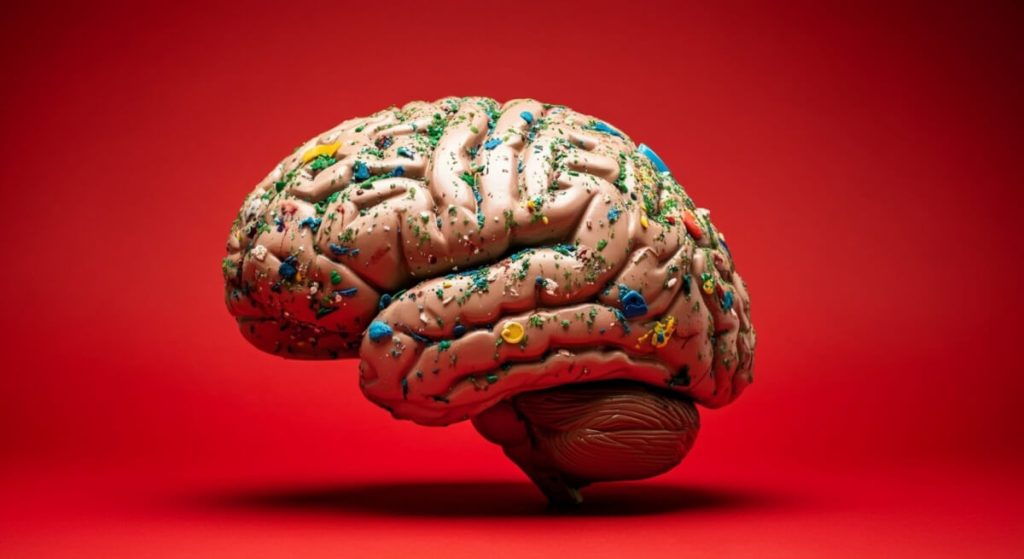

(Image by Shutterstock AI Image Generator)
Tissue samples reveal 50% surge in microplastic levels over just 8 years
In a nutshell
- University of New Mexico researchers found microplastic concentrations in human brain tissue have increased by 50% between 2016 and 2024, with levels about 12 times higher than those found in liver or kidney samples. Most particles come from everyday plastics like water bottles and food containers.
- Brain samples from individuals with dementia contained up to ten times more plastic than those without the condition, though researchers emphasize they cannot yet determine if microplastics contribute to the disease. The particles appear to accumulate particularly in fatty tissues, including the protective sheaths around nerve cells.
- Even if plastic production stopped today, existing plastics will continue breaking down into microscopic particles for decades to come. Researchers suggest commercial meat production may be concentrating these particles in our food chain through contaminated water, animal feed, and fertilizers.
ALBUQUERQUE, N.M. — The plastic pollution crisis just got personal. A new study from the University of New Mexico reveals an unsettling truth: microscopic plastic particles are accumulating in human brains at significantly higher concentrations than in other organs – and these levels have surged 50% in just eight years.
Scientists examining postmortem brain tissue found microplastic concentrations were about 12 times higher than those in the liver or kidney. Even more concerning, brain samples from individuals with dementia contained up to ten times more plastic than those without the condition, though researchers emphasize it’s too early to determine if microplastics contribute to the disease.
“This really changes the landscape. It makes it so much more personal,” says lead researcher Matthew Campen, Distinguished and Regents’ Professor at UNM’s College of Pharmacy, in a statement.
The Microplastic Problem
Microplastics come from the breakdown of everyday items like water bottles, food containers, and synthetic clothing. As these products degrade, they create tiny fragments smaller than 5 millimeters – about the size of a sesame seed at their largest. But many particles are much smaller, invisible to the naked eye.


Previous studies have detected microplastics in human blood, placentas, and various organs, but this new research shows an unprecedented concentration in brain tissue. In samples collected between January and March 2024, the median level reached 4,917 micrograms per gram—roughly the weight of four to five paper clips of plastic per kilogram of brain tissue.
Most particles consisted of polyethylene, the same material used in plastic bottles and food packaging. Using advanced microscopy, researchers identified clusters of sharp plastic shards measuring 200 nanometers or less—about twice the size of a typical virus. These tiny fragments are small enough to cross the blood-brain barrier, the brain’s natural defense system against harmful substances.
Rather than chemical toxicity, researchers are particularly concerned about potential physical interference in brain function. “We start thinking that maybe these plastics obstruct blood flow in capillaries,” Campen explains. “There’s the potential that these nanomaterials interfere with the connections between axons in the brain. They could also be a seed for aggregation of proteins involved in dementia. We just don’t know.”
How Are These Plastics Getting Into the Brain?
The research team analyzed brain tissue samples from early 2016 and 2024, revealing a stark increase in plastic levels over just eight years. To establish a longer historical perspective, they also examined older brain samples from 1997 to 2013, obtained from brain banks on the East Coast. These earlier samples showed significantly lower plastic concentrations, suggesting a steady rise that parallels the global increase in plastic production and environmental contamination.


The study, published in Nature Medicine, investigated potential pathways for microplastics to enter our bodies. Researchers hypothesize that food, particularly meat, may be a major source. Commercial meat production can concentrate plastics through a cycle of contamination: farms use plastic-contaminated water for irrigation, feed crops to livestock, then use manure from those animals as fertilizer, potentially amplifying plastic levels at each step.
Another recent study revealed that commercial seafood caught off the shores of western U.S. states showed high levels of microplastic contamination.
Once inside the body, these particles show a striking tendency to accumulate in fat-rich tissues, including the brain’s myelin sheath—the fatty insulating layer that wraps around nerve cells and enables them to communicate effectively. This affinity for fatty tissue might explain why the brain harbors higher plastic levels than other organs.
The findings raise particular concerns about dementia. While the study cannot establish cause and effect, brain samples from individuals with various forms of dementia—including Alzheimer’s and vascular dementia—showed dramatically higher plastic concentrations. These particles appeared especially concentrated around blood vessels and in areas with clusters of immune cells, suggesting possible interference with brain function.
A Growing Concern with No Quick Fix
Even if plastic production stopped immediately, existing polymers would continue to break down into microscopic particles for decades, contributing to rising contamination levels. Campen warns this could become a “ticking time bomb” for human health.


To ensure accuracy, researchers used multiple verification methods, including chemical breakdown techniques and advanced microscopy, to confirm their findings. Their research indicates that microplastics are accumulating at increasing rates, raising urgent questions about potential health effects.
These findings mark a turning point in our understanding of plastic pollution’s impact on human health. With microplastic levels in brain tissue rising steadily, the question isn’t just about what these particles are doing in our brains — it’s about what we’re going to do about it.
Many people dismiss concerns about environmental contaminants measured in trace amounts. But, as Campen puts it, “I have yet to encounter a single human being who says, ‘There’s a bunch of plastic in my brain and I’m totally cool with that.’”
Paper Summary
Methodology
Researchers analyzed brain tissue donated through the New Mexico Office of the Medical Investigator, comparing samples from 2016 and 2024. They chemically dissolved the tissue and used centrifugation to isolate undissolved plastic particles. These particles were then heated to 600°C (pyrolysis), and the resulting gases were analyzed using mass spectrometry to identify specific polymers. The team also employed transmission electron microscopy to visually examine tissue samples and confirm the presence of nanoplastic fragments.
Results
Brain samples contained median microplastic concentrations of 3,345 μg/g in 2016 samples and 4,917 μg/g in 2024 samples – significantly higher than levels found in liver (433 μg/g) or kidney (404 μg/g) tissue. Samples from individuals with dementia showed even higher concentrations, with a median of 26,076 μg/g. Polyethylene made up approximately 75% of detected plastics.
Limitations
The researchers acknowledge several limitations: variation between samples, potential contamination during storage, and the inability to determine causation regarding dementia correlation. Additionally, current analytical techniques may underestimate true plastic concentrations, as some particles could be too small for detection or lost during processing.
Discussion and Implications
This research raises urgent questions about the health impacts of accumulated microplastics in brain tissue. While plastic is generally considered biologically inert, the physical presence of sharp nanoscale fragments could potentially disrupt blood flow, neural connections, or protein aggregation. The increasing concentration over time suggests this problem will likely worsen before it improves.
Funding and Disclosures
The research was funded by multiple National Institutes of Health grants. The authors declared no competing interests.
Publication Information
The study “Bioaccumulation of microplastics in decedent human brains” was published in Nature Medicine on February 3, 2025. DOI: 10.1038/s41591-024-03453-1







